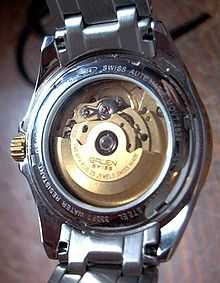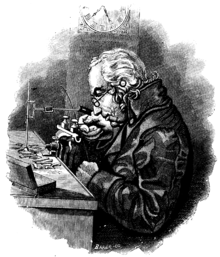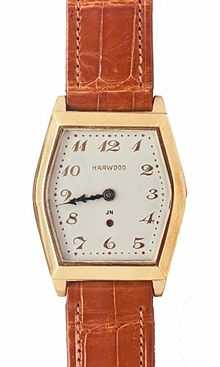Automatic watch

An automatic or self-winding watch is a mechanical watch in which the mainspring is wound automatically as a result of natural motion of the wearer's arm, to provide energy to run the watch, making manual winding unnecessary. A mechanical watch which is neither self-winding nor electrically driven is called a manual watch. Many of the mechanical watches sold today are self-winding.
How it works
A mechanical watch is powered by an internal spiral mainspring which turns the gears that move the hands. The spring loses energy as the watch runs, so in a manual watch movement the spring must be wound periodically by turning a small knob on the case, the crown, to provide energy to run the watch. Otherwise, once the energy in the mainspring runs out, it stops.
A self-winding watch movement has a mechanism which winds the mainspring.[1] The watch contains an eccentric weight (the rotor), which turns on a pivot. The normal movements of the user's arm cause the rotor to pivot on its staff, which is attached to a ratcheted winding mechanism. The motion of the wearer's arm is thereby translated into circular motion of the rotor which, through a series of reverser and reducing gears, eventually winds the mainspring. There are many different designs for modern self-winding mechanisms. Some designs allow winding of the watch to take place while the rotor swings in only one direction while other, more advanced, mechanisms have two ratchets and wind the mainspring during both clockwise and counterclockwise rotor motions.
The fully wound mainspring in a typical watch can store enough energy reserve for roughly two days, allowing the watch to keep running through the night while stationary. In many cases automatic watches can also be wound manually by turning the crown, so the watch can be kept running when not worn, and in case the wearer's wrist motions are not sufficient to keep it wound automatically.[2]
Preventing overwinding
Self-winding mechanisms continue working even after the mainspring is fully wound up. If a simple mainspring was used, this would put excessive tension on the mainspring. This could break the mainspring, and even if it did not, it would cause 'knocking' or 'banking'. The excessive drive force applied to the watch movement gear train could make the balance wheel rotate with excessive amplitude, causing the impulse pin to hit the back of the pallet fork horns. This would make the watch run fast, and could break the impulse pin. To prevent this, a slipping clutch device is used on the mainspring so it cannot be overwound.
The slipping spring or 'bridle'
The 'slipping mainspring' device was patented by Adrien Philippe, one of the founders of Patek Philippe, on 16 June 1863,[3] long before self-winding watches. It was invented to allow simultaneous winding of two mainspring barrels. In an ordinary watch mainspring barrel, the outer end of the spiral mainspring is attached to the inside of the barrel. In the slipping barrel, the mainspring is attached to a circular steel expansion spring, often called the 'bridle', which presses against the inside wall of the barrel, which has serrations or notches to hold it.[4]
As long as the mainspring is less than fully wound, the bridle holds the mainspring by friction to the barrel wall, allowing the mainspring to be wound. When the mainspring reaches full wind, its force is stronger than the bridle spring, and further winding pulls the bridle loose from the notches and it simply slides along the wall, preventing the mainspring from being wound further. The bridle must grip the barrel wall with just the right force to allow the mainspring to wind fully but not overwind. If it grips too loosely, the bridle will begin to slip before the mainspring is fully wound, a defect known as 'mainspring creep' which results in a shortened reserve power time.[5]
A further advantage of this device is that the mainspring cannot be broken by excessive manual winding. This feature is often described in watch company advertising as an "unbreakable mainspring".
Automatic quartz or kinetic movement
After the introduction of quartz watches, electronic automatic quartz watches powered by arm movement were developed by Seiko. Typically a weighted rotor turns a tiny electrical generator, charging a rechargeable battery or low-leakage capacitor, which powers the quartz movement. This automatic quartz arrangement provides the accuracy of a quartz movement without the need for routine battery replacement. An alternative power source with functionally similar results is a photoelectric cell ("solar watch").
Watch winders
Watch winders are available to store automatic watches and keep them wound for people who do not wear their automatic watches every day. This is particularly advantageous where a watch has complications, such as perpetual calendars or moon phases. A watch winder can hold one or more watches and move them in circular patterns to approximate to the human movement which otherwise keeps the self-winding mechanism working. Older mechanical watches should be wound and running as much as possible to prevent their lubricants from congealing over time, diminishing accuracy. Modern mechanical watches generally use synthetic oil; whether or not synthetic oils congeal is a point of contention among watch experts. A full service (which involves disassembly, cleaning and re-lubrication) should be performed at least every five years to keep the watch as accurate as possible.
History
Origins: 1773–79

The earliest reference to self-winding watches is at the end of 1773 when a newspaper reported that Joseph Tlustos had invented a watch that did not need to be wound. But his idea was probably based on the myth of perpetual motion, and it is unlikely to be a practical solution to the problem of self-winding watches. In 1776 Joseph Gallmayr also stated that he had made a self-winding watch, but there is no evidence to support this claim.
The earliest credible evidence for a successful design is the watch made by the Swiss watchmaker Abraham-Louis Perrelet, who lived in Le Locle. In late 1776 or early 1777, he invented a self-winding mechanism for pocket watches. It worked on the same principle as a modern pedometer, having an oscillating weight inside the watch that moved up and down. The Geneva Society of Arts, reporting on this watch in 1777, stated that 15 minutes walking was necessary to fully wind the watch.
In 1777 Abraham-Louis Breguet also became interested in the idea and his first attempts led him to make a self-winding mechanism with a barrel remontoir. Although a successful design, it was too complex and expensive for it to be manufactured and sold.
About the end of 1777 or early 1778, Hubert Sarton designed a watch with a rotor mechanism, and towards the end of 1778, Sarton sent a watch to the French Academy of Sciences and a report was written which, together with a drawing, gave a detailed description of the mechanism. Sarton's design is similar to those used in modern wristwatches, which has led to the conclusion that Sarton, not Perrelet, was the father of modern automatic watches, although there is no evidence linking the 18th century design to 20th century developments.
About the end of 1778 or early 1779, Abraham-Louis Breguet became aware of Perrelet's watches, probably through Louis Recordon, who traveled from Geneva to London via Le Locle. Breguet studied and improved the design and began making them.
Although a few self-winding watches were made from then on, for more than one hundred years these watches were rare, until the advent of the wristwatch.[6]
'Bumper' wristwatches: 1923

Self-winding mechanisms were more successful in wristwatches than in pocket watches because the arm moves more during daily activity than does the torso. The first self-winding wristwatch did not appear until after World War I, when wristwatches became popular. It had been invented in 1923 by John Harwood, a watch repairer from Bolton[7][8] who took out a UK patent with his financial backer, Harry Cutts, on 7 July 1923, and obtained a corresponding Swiss patent on 16 October 1923.[9] The Harwood system used a pivoting weight which swung as the wearer moved, winding the mainspring. The ratchet mechanism wound the mainspring only when moving in one direction. The weight did not rotate a full 360°; spring bumpers limited its swing to about 180°, to encourage a back and forth motion.[10] This early type of self-winding mechanism is now referred to as a 'hammer' or 'bumper'.
When fully wound, Harwood's watch would run for 12 hours autonomously. It did not have a conventional stem winder, so the hands were moved manually by rotating a bezel around the face of the watch. The watches were first produced with the help of Swiss watch manufacturer Fortis and went on sale in 1928. 30,000 were made before the Harwood Self-Winding Watch Company collapsed in 1931 in the Great Depression. 'Bumper' watches were the first commercially successful automatic watches; they were made by several high grade watch manufacturers during the 1930s and 1940s.
Rolex
The Rolex Watch Company improved Harwood's design in 1930 and used it as the basis for the Rolex Oyster Perpetual, in which the centrally mounted semi-circular weight could rotate through a full 360° rather than the 300° of the 'bumper' winder. Rolex's version also increased the amount of energy stored in the mainspring, allowing it to run autonomously for up to 35 hours.
Eterna ball bearing
The next development for automatic watches came in 1948 from Eterna Watch. To wind a watch effectively, one of the chief requirements of a rotor is heft. Until this point, the best bearing used in any watch was a jewel bearing, which perfectly suits the small gears of a watch. A rotor, on the other hand, requires a different solution. In 1948, Eterna introduced the solution that is still in use today: ball bearings. Ball bearings provide robust support for a heavy object to rotate smoothly and reliably even under abnormal stress, such as if the watch were dropped.
Since the 1960s
By the 1960s, automatic winding had become standard in quality mechanical watches. Because the weighted rotor needed in an automatic watch takes up a lot of space in the case, increasing its thickness, some manufacturers of quality watches, such as Patek Philippe, continue to design manually wound watches, which can be as thin as 1.77 millimeters.
See also
References
- ↑ Horologyzone. "Automatic Watch Movement Disassembly". Horologyzone.com. Retrieved 2014-05-01.
- ↑ A notable exception is Seiko's wide range of watches based on the company's 7S26 movement, which cannot be hand-wound.
- ↑ Patent No. 58921
- ↑ "The Mainspring of an Automatic Watch". Glossary. TimeZone Watch School. Archived from the original on 6 April 2008. Retrieved 2008-04-11. Diagram showing operation of slipping mainspring.
- ↑ "Hints". British Horological Institute.
- ↑ Watkins, Richard. "The Origins of Self-Winding Watches, 1773 to 1779". Retrieved May 23, 2014.
- ↑ [Bolton Museum]
- ↑ Press release by UK Patent Office on 80th anniversary of self-winding watch patent
- ↑ "16 October 1923". Brainy History. 1923-10-16. Retrieved 2014-05-01.
- ↑ "Bumper Automatic vs. Full Rotor Automatic". FAQ. FinerTimes.com. Archived from the original on 19 April 2008. Retrieved 2008-04-17.
Hampel, H., Automatic Wristwatches from Switzerland, Schiffer, Atglen, 1994.
External links
- A visual guide to the gears that make bi-directional winding possible
- A detailed evaluation of the mechanics of the Seiko 7S26 automatic watch movement
- Ranfft, Roland. "Automatics for Everyone". About watches. Ranfft Watches. Retrieved 2008-04-17. Photos of early automatic movements on German watch vendor site, including the Harwood
- The History of the Watch Rotor from The Watch Magazine